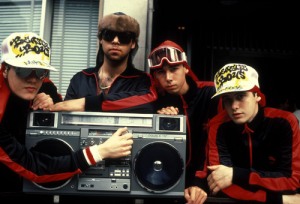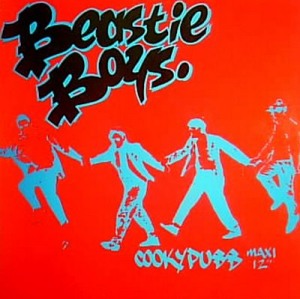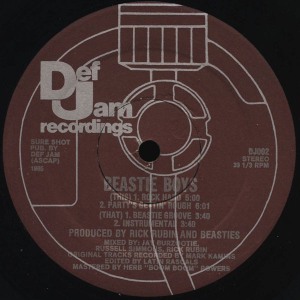
Following the recent passing of the Beastie Boys’ Adam Yauch, I found myself tracking down countless memorials for MCA. They varied from superb (Passion of the Weiss, Grantland, this MetaFilter post) to bizarrely off-point (Washington Times) to economic and incisive (a friend’s “He was ill for a very long time”), but the general narrative of Yauch’s life was consistent: he transitioned from wild-and-crazy youth to socially conscious adult without losing his fan base, which was no minor achievement.
Yet I’m not here to relive and relay years of listening experience, because in comparison to the cited retrospectives, I simply didn’t log the hours. I was a dabbler, plain and simple. I remember being energized by their live-instruments performance of “Sabotage” at the 1994 MTV Music Video Awards, but if there’s stereotypical indication of my default setting as a guitar rockist, that’s it. When they had a video on MTV, I’d gladly watch it, when my friends put on one of their albums in high school, I enjoyed it (at least until I heard “Intergalactic” for the eight-millionth time in the summer of ’98), when they made a heads-only guest appearance on Futurama, I laughed. But to qualify myself as a true-blood fan—one of the people who poured over issues of Grand Royal magazine—would be disingenuous.
Instead, I’m here because those memorials prodded my lingering curiosity over the group’s full discography—something that’s been festering for years—over the edge. In addition to my excitement to spend time with Paul’s Boutique, I have plenty of questions. What kept me from digging deeper earlier? Did they really start out as a hardcore band? Does License to Ill hold any appeal for a 31-year-old dad? Will I recognize the countless samples? Could I reflexively recite “Intergalactic”? Are their late-career records under-appreciated?
To find out, I’ll cover their eight full-length releases and the key singles/EPs from their thirty-year run.

Polly Wog Stew EP, Rat Cage, 1982
Highlights: “Egg Raid on Mojo”
Lowlights: The possibility of hearing it twice
Yes, the Beastie Boys began as a hardcore band. It’s fun to imagine other ’80s hip-hop notables arriving with equally bizarre musical origin stories: Eric B. and Rakim starting out as a jazz-fusion duo; Kool Keith housing things as a synth-pop troubadour; Salt-N-Pepa authoring chipper Go-Go’s-esque power pop; Biz Markie bringing the laughs with “Weird Al” Yankovic-style parodies. But whereas the transition from Point A to Point B for those hypothetical scenarios would mimic the slipshod plotting of a direct-to-video action flick, there’s a logical arc between the Beasties’ earliest days as NYC hardcore punks and their coming of age (sort of) as beer-swilling MCs on License to Ill.
The seeds of the Beastie Boys were planted in 1981 with Michael Diamond’s involvement in The Young Aborigines, a four-piece described as “experimental” and supposedly influenced by Siouxsie & the Banshees and Joy Division. (Either these were the hippest fourteen-year-olds in existence, prior to Spencer Tweedy of course, or both points are complete bullshit. Not knowing how to write or perform songs does not mean you’re experimental; wandering through a murky outro does not mean you’re post-punk.) Mercifully for my ears, there’s no official document of those songs, although rehearsal tapes, a live recording, and a failed studio session exist. The group’s default lineup was Diamond on drums, Kate Schellenbach on percussion, John Berry on guitar, and Jeremy Shatan on bass, but the members switched instruments for one song called “Asshole,” with Diamond singing and Schellenbach drumming. When Shatan left NYC for the summer of 1981, the three other members indulged their hardcore leanings and that alternate line-up as the Beastie Boys. Adam Yauch replaced the hardcore-averse Shatan on bass and the earliest incarnation of the Beastie Boys—the one documented on Polly Wog Stew—was solidified.
The Beastie Boys played their first show on August 5, 1981, Adam Yauch’s seventeenth birthday. Michael Diamond and Kate Schellenbach were still fifteen. Unlike later gigs at name venues like Max’s Kansas City, Irving Plaza, and CBGB’s, this show occurred at John Berry’s house, presumably his parents’ house. I stress the members’ ages and the show’s location for a reason: Polly Wog Stew is the music of teenagers.
A spin of Polly Wog Stew whopping eleven-minute runtime reveals the following subjects: jumping turnstiles, fondness for Batman and Crass, not fighting on Friday night, smoking pot vs. being straight-edge, hating farms, throwing eggs. It’s delivered with at top speed (excluding the two drifting, faux-experimental passages in “Jimi” and “Ode to…”) with Diamond’s snotty yelp leading the way. Praising a group’s “youthful energy” is a gentle way to imply that the musicianship is sloppy, and on that tip, the Beastie Boys had a lot of youthful energy. “Egg Raid on Mojo” is the highlight, but unless you’re a Beastie Boys super-fan or a historian of early ’80s NYC hardcore, one spin of Polly Wog Stew will be more than enough.
Then again, I don’t currently qualify as either of those things. I prefer post-punk to punk, post-hardcore to hardcore. Both punk and hardcore can be viewed as ends to themselves or gateways to something new. You can master the tenets of punk (thereby leveling up to “punk as fuck”), you can play harder and faster hardcore, but once you perfect the formula of either, you’re steadfastly avoiding change as the aforementioned “youthful energy” runs out and you turn a decrepit 22. On the other side, you can recognize the need to evolve, not merely refine, and incorporate elements outside of the defined parameters of the genre. In the latter scenario, Ian MacKaye forms Embrace and then Fugazi, J. Robbins begins Jawbox, and Drive Like Jehu issues Yank Crime. No, I’m not biased at all to one side of the ledger.
The gradual process for those artists of going from point A to point B, Minor Threat to Fugazi, often involves the following steps: slow down, find new and possibly better collaborators, identify what’s important to your music to begin with (social/political awareness), grow up as individuals and as writers (no more “Guilty of Being White”), expand your influences (reggae). Applying that to the Beastie Boys, they slowed down enough that you could understand what Michael Diamond was saying, brought Adam Horowitz on board in 1983 and left Schellenbach behind in 1984, extracted the prankster appeal of “Egg Raid on Mojo,” matured got laid, and jumped on the growing hip-hop trend. Abandoning hardcore made too much sense from both commercial and creative perspectives, but as Check Your Head, Ill Communication, and especially the Aglio e Olio EP prove, they didn’t leave it completely behind.
The video evidence of the Beasties’ hardcore days—a 1984 cable access spot with Adam Horowitz on guitar—is more enjoyable than the EP. There’s also an eighteen-minute program on The Young Aborigines / The Beastie Boys with interviews from John Berry and Jeremy Shatan. The latter includes snippets of some YA music, so proceed with caution.

Cooky Puss EP, Rat Cage, 1983
Highlights: “Cooky Puss”
Lowlights: “Beastie Revolution”
“Cooky Puss” was the Beastie Boys’ first hip-hop song, or, less generously, first hip-hop skit. Their last release as a four-piece, “Cooky Puss” lays prank calls to Carvel Ice Cream over turntable scratches, Steve Martin samples, and live bass and drums. Its success in NYC dance clubs encouraged the Beastie Boys to continue in this direction and a settlement over British Airways’ illegal use (imagine that) of “Beastie Revolution” funded the time and space to improve their act.
Although “Cooky Puss” remains a semi-amusing lark, the EP longs for more ballast. After the title track, there’s “Bonus Batter,” an instrumental extension of “Cooky Puss,” “Beastie Revolution,” an initially amusing but ultimately interminable piss-take on reggae, and a censored version of “Cooky Puss.” It was later bundled with Polly Wog Stew as Some Old Bullshit, a remarkably apt title.
Most importantly, it’s time to say adios to Kate Schellenbach. The sample-oriented Cooky Puss wrote her departure on the wall, and after going away for a weekend in 1984, she returned to find her bandmates wearing matching track suits and chilling with new cohort Rick Rubin. In essence, the female drummer was replaced by a giant inflatable penis. To their credit, the Beastie Boys did sign Luscious Jackson (the ’90s alt-rock group containing Schellenbach and “Holy Snappers” name-drop Jill Cuniff) to their Grand Royal imprint in 1992.

Rock Hard EP, Def Jam, 1985
Highlights: Ad-Rock's verse in “Beastie Groove”
Low Points: "Party's Getting Rough"
Cooky Puss pushed the Beastie Boys most of the way toward Def Jam hip-hop, but Rock Hard is the first full embrace. Three MCs bobbing and weaving through verses, exhibiting no small debt to fellow Rubinites Run-D.M.C.? Check. Up-front drum machine beats? Check. Sampled guitar riffs? Check. Turntable scratching? Check. The pieces are in place, but the execution needs some practice.
The title track’s use of AC/DC’s “Back in Black” caused the initial release to be recalled and prevented a reissue for 22 years, when it was finally repressed in Europe. Mike D. said that “AC/DC could not get with the sample concept” but there’s nothing subtle or ingenious about the use of that song’s instantly recognizable guitar riff here. First, it’s not part of the guitar riff, it’s the entire verse. Second, aside from the presence of three guys rapping over it, there’s no contrasting element. Replacing the drums with rudimentary 808 beats makes little difference. Licensed to Ill isn’t particularly coy about its samples; opening track “Rhymin & Stealin” is appropriately titled, but at least there are three sources on that song. “Rock Hard” is that riff, over and over again.
I realize that harping on a 1985 hip-hop record’s production values as being limited is an obvious, tired argument, but keep “Rock Hard” in mind as a starting place. It establishes the path of least resistance (or perhaps effort) to Licensed to Ill’s “loud guitars and drum machines” success and later the actual recontextualization of samples on Paul’s Boutique. But as-is in 2012, “Rock Hard” sounds like a mash-up, something that should be tiresome to anyone who read a music blog from 2000-2005.
As for the rapping on “Rock Hard,” it’s also a work in progress, to put it gently. If not for MCA’s gruffer delivery, it would be difficult to tell the three MCs apart. Lyrically the theme is “We’re here and we’re great,” which occasionally stumbles onto a worthwhile nugget like “Like claps of thunder from the cumulus clouds” but mostly offers eye-rollers like “Sometimes I write rhythms rather write rhymes / He writes his and I write mine” when put in print.
The two other real tracks on the EP further their pre-Licensed to Ill development. “Party’s Getting Rough” is looser, to say the least: a six-minute hip-hop jam ambling between “[Insert Name] has got the groove!” shout-outs, a mid-song skit about the Beastie Boys’ taking over the song’s production (get this, they make the drums louder), and an extended, scratch-heavy outro. Much like “Beastie Revolution,” it’s initially appealing but quickly wears thin. “Beastie Groove” gives each MC some breathing room, with MCA taking the lead, Ad-Rock showing off with a speedy passage, and Mike D. pulling up the rear, literally and figuratively. Ad-Rock’s verse prefaces the sexed-up focus of Licensed to Ill with “Cause I'm a man who needs no introduction / Got a big tool of reproduction.” Like everything else on Rock Hard, it’s a dry run.
As per mid-’80s regulations, an instrumental mix of “Beastie Groove” closes out the EP, offering you a chance to better Mike D.’s insightful “Take that if you think you can / Meet the floor and that to this here rap” couplet.
A better pre-Licensed to Ill track appears on the soundtrack to the 1985 Def Jam feature film Krush Groove. “She’s On It” draws a much clearer blueprint for the album: less obviously canned guitar riffs, more obvious sexual innuendo, and sparse verses. In addition to roughly 200 white girls running around in bikinis, the video shows Rick Rubin “producing” the Boys' Looney Tunes hijinks and underscores just how damned young Ad-Rock was in 1985.
|

